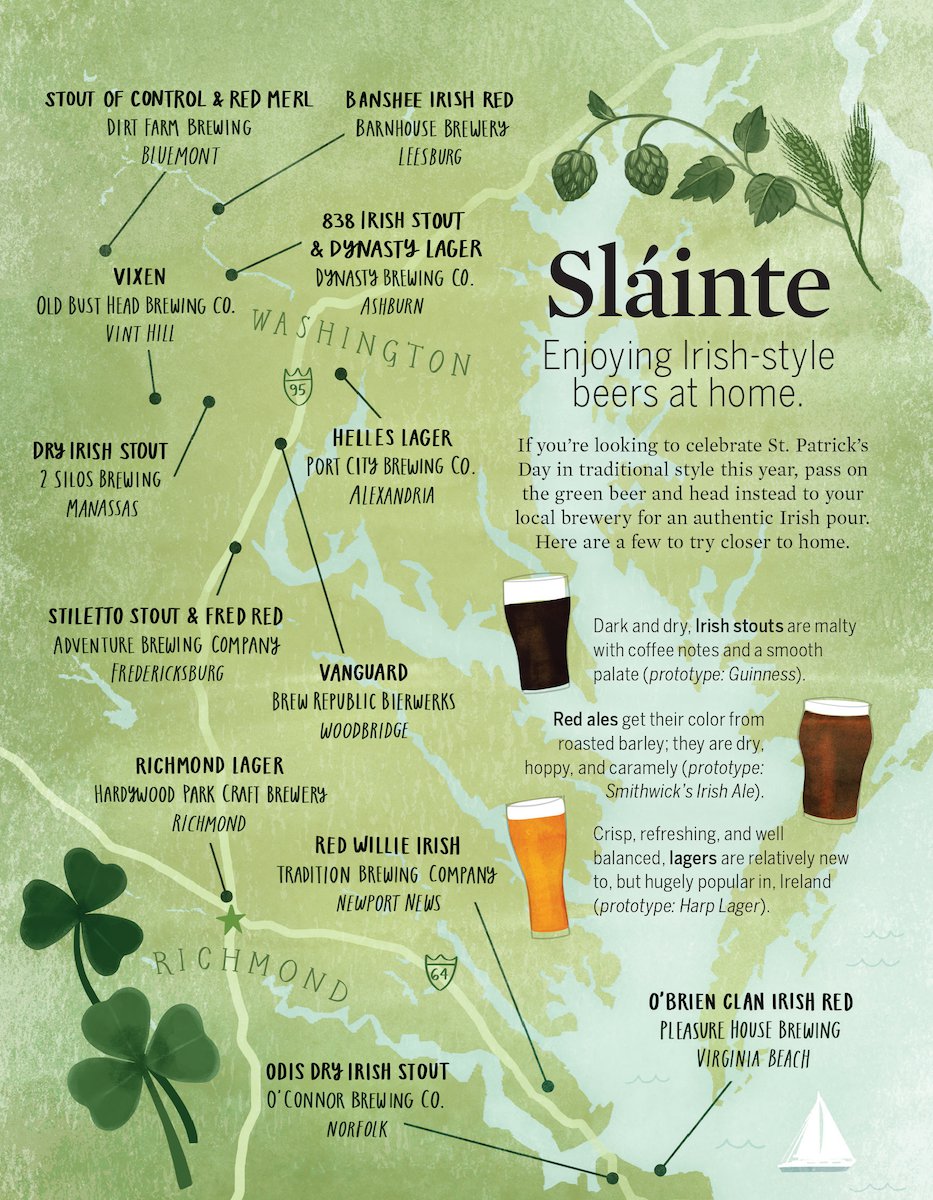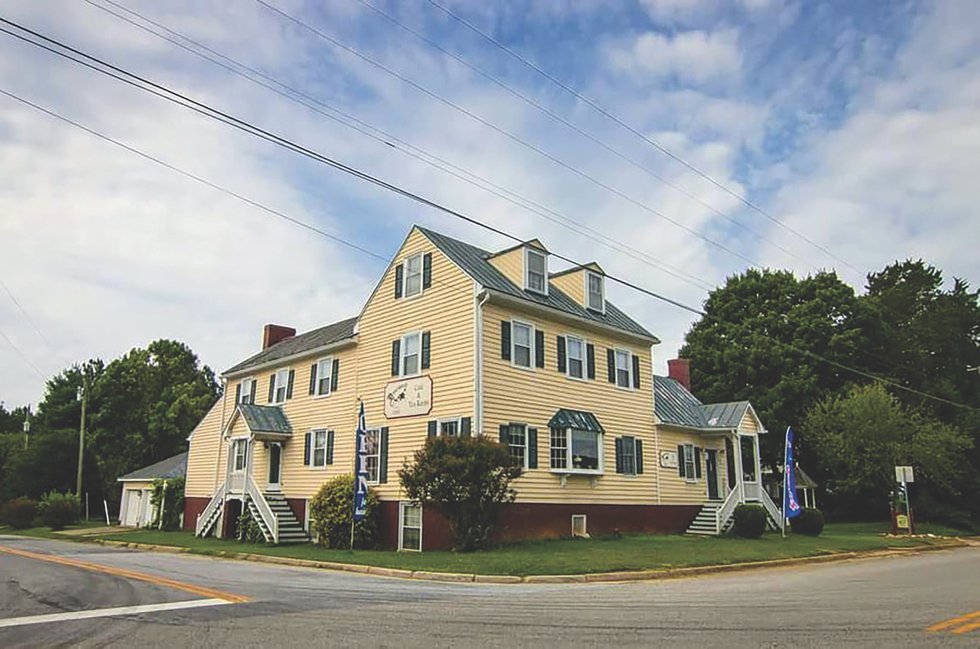Legend Brewing Company started as a one-man brewpub. Now it’s the state’s biggest independently owned craft brewer, and, at age 16, hitting its stride with broader distribution and a new product guaranteed to please Joe Six-Pack. Plus: Beer pairings.

Beer feat


French onion soup

Beer-sausage
Sausage.

Vlaamse stoof karbonaden—Flemish beef stew with beer and onions.

Mussels in beer.
Americans love beer, and Virginians love beer more than most. According to the national Brewers Association, the commonwealth has more craft breweries per capita than any other state in the Southeast. Craft breweries are relatively small, independent companies that focus on producing high-quality beers in traditional styles. And with 32 craft breweries, Virginia has one for every 242,000 Virginians. To put that in perspective, Texas has one craft brewery per 675,000 people. And our neighbors in Tennessee, Kentucky and West Virginia combined can only muster 27 craft breweries. Clearly, Virginians are serious about their suds.
Tom Martin certainly takes beer seriously. So much so, in fact, that in 1993 he quit his job as a brewer for Anheuser-Busch, the global colossus, and started his own little firm in Richmond: Legend Brewing Company. For Martin, jumping from a multinational to a tiny operation with one employee—himself—was a huge transition, but he enjoyed serving his very own beer (and sandwiches) to customers in a pub only a few feet away from where he brewed it. By early 1994, Legend was selling kegs, which posed a peculiar problem for the one-man operation: If a client needed a keg during bar hours, Martin had to kick the pub patrons out while he delivered the beer. (They were welcome to wait outside, and he let them back in when he returned.)
Sixteen years later, Legend is still tucked away on West 7th Street, in a Richmond warehouse district south of the James River, but it’s hardly the same place. The space that used to be the entire pub is now just the prep kitchen for an airy restaurant that serves a lot more than sandwiches (clam bake, anyone?). You can see the river from the pub’s deck, and the dining area is big enough to accommodate several football teams. Down a flight of stairs, just beneath the bar, are rooms filled with tanks, vats and bottling equipment. There’s a warehouse filled with kegs, bottles and bags of barley and malt. It’s not a one-man show anymore—the brewing operation alone consists of more than a dozen people.
Today Legend is not only the largest independently owned brewing company in Virginia, but it continues to grow at an impressive rate, despite the lackluster economy. According to Dave Gott, Legend’s vice president of operations, Legend’s sales grew by a respectable 10 percent annually between 2004 and 2008, and last year was even better. After switching to a different distributor, the brewer’s sales shot up approximately 25 percent, says Gott. “And I think 2010 is going to be gigantic for us.”
Maybe that’s because word has got around about the quality of the beer. Tony Wilson, general manager of the Green Leafe Café in Williamsburg, praises Legend as “one of the best craft breweries in this part of the country. It consistently produces very good beers. Their brown ale in particular is exceptionally good, and every time they put out a seasonal beer, we make sure to have it—a guaranteed seller. When you’re in the business of selling beer, a guaranteed seller is always welcome.”
The fact that Legend sells more beer than any other independent brewery in Virginia is particularly notable given that few people outside of central Virginia have heard of the company or the brand. For nearly all of its existence, about 80 percent of Legend’s sales have been within 50 miles of Richmond. Beer cognoscenti haven taken notice—Legend’s Pilsner was well-received by beer guru Michael Jackson, and its Brown Ale was named a Grand Champion at the 2006 United States Beer Tasting Championship—but most beer lovers looking for the brew have had a hard time finding it. That’s changing now, as the company is steadily broadening its distribution to restaurants around Virginia.
Legend’s fortunes should get an even bigger boost now that it has begun selling the beer industry’s most emblematic product—the six-pack. Believe it or not, Legend did not sell its first 12-ounce beer, much less its first six-pack, until September 2009. Prior to that, Legend only sold its beer in kegs or 22-ounce bottles. Now the firm offers six-packs of its Pale Ale, Lager, Brown Ale, and Golden Ale—an India pale ale. (Those of you looking for porter, pilsner or seasonal beers will have to stick to the 22-ounce bottles.) Beer industry veterans say that consumers are more apt to try new beers sold in 12-ounce bottles (individually or in six-packs)—and that should bode well for Legend as it seeks to become something more than a well-regarded local brand.
As Gott says, “We hope to go wherever beer drinkers are looking for good beer.”
Complex, Malty, Unconventional: Beer pairs well with food. Just make sure of your matchups!
When people think of pairing food and drink, they usually think of wine. You’ve heard the question “What type of wine should I serve with this meal?” Don’t limit yourself. Serving the right beer with your food can be every bit as rewarding, especially for casual occasions. “The same things that make wine and food pair well together make beer and food pair well together,” says Scott Calvert, wine director and self-described “beverage guy” for the famed Inn at Little Washington. Beer and wine can have similar aromas and a similar range of acidity, and Calvert compares the tannins in wine to the hoppy bitterness found in beers.
That’s good news if you already know how to pair food and wine. If you don’t, start with this simple rule: Don’t overwhelm the food or the beer. For example, if you’re serving a heavy dish (like pot roast), you shouldn’t serve a lightweight beer (like a pilsner)—it won’t stand up to the robust meal. On the other hand, you wouldn’t want to serve a rich porter with a summer salad—the salad would be overpowered. Try to find a beer that brings out the flavors in the meal but doesn’t bury them.
“I, for one, like complex, roasty beers paired with strong-flavored foods,” says Tony Wilson, general manager of the Green Leafe Café in Williamsburg. For example, he notes that Legend Brown Ale pairs particularly well with beef or lamb, “because it has a nice malty flavor and it is well-balanced. It complements the food without overpowering it.”
Food with delicate flavors, like seafood, can be more challenging. “But it can be done,” says Cathal Armstrong, chef of Alexandria’s Restaurant Eve. “As a general rule, with fish I look for a beer that has a crisp finish with a little bit of acidity,” Armstrong says, “like a hefeweisen.” Armstrong also notes that regional beers often pair well with regional foods. For example, “Beer and cheese can be a wonderful combination. Look for beers from the region the cheese is made.” And, adds Armstrong, don’t forget the one thing that may go best of all with a before-dinner beer: Virginia peanuts. “They have a natural affinity with beer.”
FRENCH ONION SOUP WITH BEER
Serve with a pilsner.
6 large yellow onions, sliced very finely
1 tablespoon chopped garlic
3 tablespoons unsalted butter
2 tablespoons extra virgin olive oil
4 cups beef broth
2 cups chicken broth
2 cups lager-style beer
herb sachet: Tie into a bit of cheese cloth 1 bay leaf, 3 sprigs thyme, 2 sprigs marjoram, 1 small sprig rosemary.
Melt butter, add olive oil and sauté the onions until golden brown. Add the garlic and continue to cook on low heat for 5 to 6 minutes. The onions should be cooked at a fairly low temperature so they will not burn—this may take 20-30 minutes. Next, add the warm beef and chicken broth and the beer. Simmer with the herb sachet for about 20-30 minutes, and season well with salt and pepper.
For the croutons:
Use sliced French bread (or your favorite bread) and, for each bowl of soup, cut a crouton from the bread with a circle cutter. Toast the bread and rub with a smashed clove of garlic, then top with one slice of Gruyere cheese and 1 teaspoon of grated Parmesan. Pour soup into oven-proof bowls, and place a crouton on top of each soup. Brown nicely under the broiler.
SAUSAGES
Serve with a lager.
sausages, as many as you need of your favorite, such as bratwurst
onions, sliced; one per each four sausages
butter or olive oil
Over medium heat, brown the sausages on all sides, and then finish in a 350-degree oven for 10 minutes. Meanwhile, sauté the onions in the butter or olive oil until golden, about 10-12 minutes.
VLAAMSE STOOF KARBONADEN (Flemish beef stew with beer and onions)
Serve with dark beer.
3-4 pounds beef brisket
4 large onions, sliced
4 cloves garlic, chopped
2 tablespoons flour
1 bay leaf
3 sprigs thyme
1 1⁄2 sticks unsalted butter
1 16-ounce bottle dark beer
2 tablespoons Dijon mustard
salt
pepper
Cut the beef into 1 1⁄2- to 2-inch cubes. Over medium-high heat, melt one stick of the butter in a large, heavy-bottomed, oven-proof pot, and brown the beef well on all sides. Pour the beef into a collander and drain, reserving the excess liquid (if any). Add the remaining butter and melt it, then add the sliced onions and garlic (add more oil or butter if needed) and brown well. Combine the onions and the beef, add the flour and mix well. Now add the bay leaf, thyme and beer, and salt and pepper to taste. Cover and bake in a 350-degree oven for one hour. At this point, check to see if you need to add more beer—the dish shouldn’t be dry. Add more water if needed. Add the mustard, and continue to cook for 30 minutes, until meat is tender.
MUSSELS IN BEER
Serve with a light beer.
2-3 pounds mussels (Prince Edward Island or New Zealand Greenlips)
1 stalk celery, chopped fine
1⁄2 onion, chopped fine
1 tablespoon garlic, chopped fine
2 slices applewood-smoked bacon, diced
2 tablespoons unsalted butter
1 bay leaf
2 sprigs thyme
zest from one lemon
1 1⁄2 cups pilsner beer
salt and pepper to taste
Scrub the mussels under running water and remove any beards. Discard any mussels that are open and do not close when tapped. In a large pot, melt the butter, and add the bacon to sauté for several minutes. Add the onion, celery and garlic. Cook for 2-3 minutes, then add the beer and lemon. Next, add the mussels and cook covered until all mussels open, 8-10 minutes. Discard any that don’t open. Pour into a bowl and serve with crusty bread.








